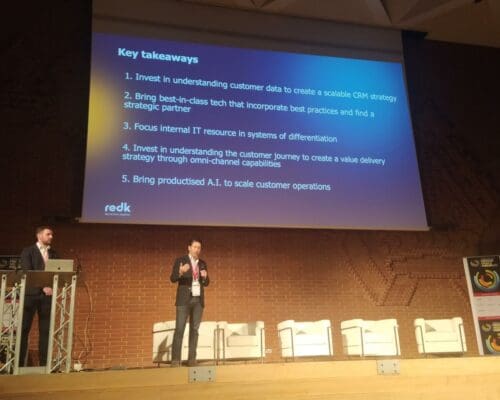As the needs of modern customers continue to evolve, financial service firms are increasingly faced with the challenge of better understanding and responding to their customers’ changing expectations. But what exactly do today’s consumers expect from their financial services providers?
Staying ahead of your competition today means offering more than just a secure yet efficient service. It also requires providing a superior customer experience that meets and exceeds customer expectations in the financial services industry. You need a top-level customer service team and an intelligent automation system to implement into your customer experience management strategies.
In this blog post, we’ll explore the major factors influencing consumer attitudes towards financial service companies, highlighting some key opportunities for financial institutions to further customer engagement and impact the customer journey in meaningful ways.
Who is the connected customer?
Here at redk, we’re experts on the connected customer.
The connected customer wants an efficient, reliable, easy-to-use finance system with 24/7 access to customer service.
We even have an entire Connected Customer Event this month dedicated to exploring how you can improve customer experiences through the digital ecosystem.
Our work with TIME Investments
Our team recently worked with TIME Investments, a specialist investment manager that provides carefully considered investments geared toward stable, long-term returns. They needed a new data strategy and a way to connect their customer-facing internal teams – while also undergoing a huge digital transformation to become more customer-centric.
So, we implemented Salesforce CRM technology into four areas of the business: sales, account management, marketing, and customer service. With our 15 years of expertise, we helped them understand the demands of the modern-day customer and how Salesforce could help meet them. Now, TIME Investments is prepared to meet customer expectations and their business goals.
Let’s get into what the connected customer wants from financial services organisations, and how you can take customer feedback to implement changes in your business.
An easy-to-use system
To meet the needs of today’s digitally savvy customers, financial services institutions across the spectrum are prioritising offering easy-to-use technologies and clear processes.
Our tech partner, Salesforce, released a white paper last year all about the future of financial services and trends across banking, insurance, and wealth management.
They found nearly one-third of customers say ease of use and transparency as their main motivations for switching to other financial service providers.
Banks and other financial services companies in this sector are responding to this demand by actively incorporating user experience into their services. This includes investing more in technologies tailored to customer data and streamlining digital experiences so customers can access the services they need quickly and easily.
From larger multinational banks to small start-ups, easy-to-use technology remains a key pillar of successful digital transformation for financial services businesses in the post-pandemic world.
Plenty of options
Financial services customers are an extremely diverse group, drawn from every age and background. While some may prefer to visit physical branches for traditional banking services, these same customers also expect the convenience and immediacy of a digital presence.
To meet these demands, businesses in the financial services sector should provide access to various channels that can operate in harmony across both digital and physical realms. As such, seamless transitions between digital and physical experiences hold the key to success.
By offering a suite of options to customers—regardless of their technical prowess or personal preference—banks ensure that they are being provided with exceptional services in accordance with modern and changing customer expectations.
Transparency and authenticity
The digital age has firmly embedded transparency and authenticity into the marketing culture, and this generation is acutely aware of its importance.
They want fast registration to services via open ID and can easily discern companies that are merely following protocol versus those genuinely dedicated to their customer’s safety and satisfaction.
Above all else, they value reviews as that is what informs their decisions—which take into account brand loyalty far less than previous generations did. If financial service organisations want to stay ahead in the future, their social capital will be key.
Personalised experiences
Today, customer expectations are far higher for the financial services industry. Customers expect a personalised experience that meets their demands and runs efficiently across all platforms.
Salesforce found that poor personalisation of customer experiences is one of the main pain points for customers that FSIs need to address.
However, they also found that only a small percentage of customers across financial services believe their provider is invested in their financial wellbeing.
“We have the spend data and insights to provide customers with so much more than just a list of their transactions. We can offer them sound and personalized financial advice. It’s a huge opportunity for the industry to prove to our customers that we care about their well-being while helping them build a better financial future.” – CIO of a U.S.-based mid-sized wealth management firm
Financial companies must strive to provide customers with a more tailored, personal experience to increase satisfaction and build stronger relationships, which will pay dividends in the long run.
Automated and responsive services
Automated and responsive services are invaluable for customers in this day and age.
The need for quality self-service is expanding, as people prefer web or mobile channels rather than communicating with an agent over the phone. Many companies, banks included, use an AI chatbot to respond to common customer queries without the need for a human being. This allows more customers to be served, and your team can focus on the more complex customer questions.
It’s imperative that banks deliver great service quality. Customers have very little hesitation about switching if they are met with opaque fees and hidden charges- or their bank fails to solve their issues quickly after being presented with them.
Transparency is key when it comes to communication between banks and their customers; for example, resolving issues promptly and on the first try is essential to maintaining loyalty from customers.
Financial advice
The modern customer expects a lot from their banking service. Not only do they want easy access to their funds and secure and reliable technology, but now customers desire financial advice too.
An increasing number of banks and other financial institutions are now offering a range of motivational products and services designed to help customers make informed choices about their finances.
As the demand for these types of services has grown, resourceful financial institutions have identified this need and developed the appropriate solutions. Customers can now benefit from an enhanced banking experience with practical support tailored to individual needs, giving them greater control over their financial decisions.
Digitisation
As consumers continue to become more tech-savvy, financial services must move away from traditional models and adapt to the changing needs of their target audience.
Digitisation and omnichannel services offer new opportunities for them to do so, allowing them to simplify processes and leverage data-driven customer insights.
Modern solutions allow customers to browse conveniently and engage with their accounts in multiple ways. Businesses can better serve their customer’s needs and develop future strategies for success.
In this way, omnichannel services provide a great opportunity for any business to stay ahead of the competition in an increasingly digital landscape.
Financial services are making big strides to meet customer expectations
To sum it up, financial services have come a long way in the past few years. With businesses being urged to move away from traditional avenues for finance and establish digitised options, these services provide:
- Convenience.
- Plenty of options for customers.
- An element of trustworthiness and authenticity.
Gone are the days when paperwork was necessary and manual labour was required to access financial services; today, banking, payments, and investments can be made in just a few clicks. There are end-to-end automated solutions in the form of advisory services that create a personalised experience for users. The opportunities available today are multiple times what they were before; it’s now up to customers to choose wisely.
At redk, we’re transformation experts, helping organisations become more digitally mature and customer-centric for more than 15 years. Talk to us to find out what we can do to add value and drive growth at your organisation.










